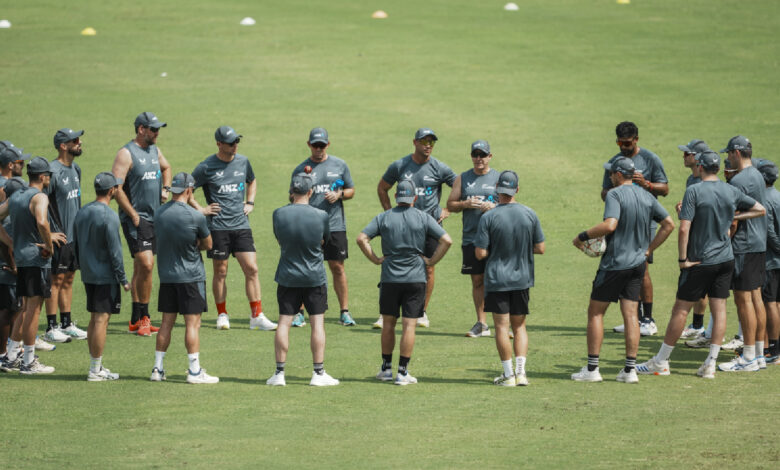Should New Zealand play Mitchell Santner in Pune Test or continue with three-seamers? | Cricket News

Mitchell Santner wore several guises at the nets on Wednesday. First, he was the footballer with a svelte first touch; then he was the plodding left-arm spinner who tied batsmen with precision; in the end he was the freewheeling batsman who struck half a dozen one-handed sixes. The Pune pitch is expected to turn and the spin-bowling all-rounder is in the selection fray, which revives an old debate. Should the teams searching for a Test win in India pack an extra spinner or stick to their traditional pace-bowling strengths?
Hory offers little clarity, rather complicates the scenario. Whilst overseas spinners had orchestrated four of India’s last five defeats at home, seamers had played titular roles in the last three series defeats of India at home. In the 2012 series, James Anderson’s bursts in Kolkata and Mumbai were instrumental in setting up the series, even though spinners Graeme Swann and Monty Panesar claimed more wickets. In 2004, Australia conquered the final frontier with Glenn McGrath, Jason Gillespie and Michael Kasprowicz claiming 43 wickets; in 1999, Shaun Pollock and his pace peers collected 29 of the 40 scalps to fashion an unprecedented series win.
Herein is New Zealand’s dilemma. To drop a seamer for an extra spinner. If so, who? The three seamers—Matt Henry, Tim Southee and Will O’Rourke—collected 17 scalps in Bengaluru, where the conditions allied with the seamers. But each seamer dutifully showed their value. Rourke’s bounce, high release points and movement either ways tormented India’s batsmen. Henry brings slippery pace; Southee a century of Test experience and expertise in seaming the ball even in drier conditions, besides batting utility. Removing even one of them could imbalance the team. Take out O’Rourke, they lose the X factor. If dual-bounce kicks, he could be a deadly proposition. Bench Henry and they will be short on pace. Swap Southee for Santner, they become starved of experience in as immense a game as this. The pace-spin switch disrupts the uncomplicated balance of the team too. In Bengaluru, they had three different types of seamers, a special spinner, two part-time spinners, seven special batsmen and two lower-order hands.
At the same time, New Zealand needs to bolster their spin resources. Ajaz Patel is their only special one, the ten-wicket hero in the last tour. He was largely shoddy in Bengaluru, but the conditions were difficult for even the home spinners to make an impact. Glenn Phillips looked the sharpest, even nabbed Virat Kohli’s wicket. Rachin Ravindra’s bowling has digressed from his last tour. Santner could replace one of Phillips or Patel, Rachin being irreplaceable, but displacing Patel would weaken the bowling, just as removing Phillips would diminish the batting. It’s not feasible to replace Santner with an under-firing special batsman like Daryll Mitchell or hand over the keeping gloves to one of their openers (both Devon Conway and Tom Latham have kept wickets) and bench Tom Blundell. It’s like one of those Chinese puzzles, looks more complicated with each passing look.
Or, New Zealand could follow the template of the last three victors on these shores. That is to stick to the type. England played two special spinners because both were canny enough. Graeme Swann is arguably the finest off-spinner with Ravi Ashwin in the post Muttiah Muralitharan era; Monty Panesar enjoyed a renaissance, even though that was short-lived. The masterful Anderson performed a lot of heavy-lifting, especially with the old ball. In 2004, Shane Warne enjoyed one good match, six of his 14 wickets came in the Chennai Test.
The sustained nemesis of Indian batsmen were the unsung Gillespie (20), metronome McGrath (14) and Kasprowicz (9), the workhorse. The latter once explained their methods: “Pace bowling was our biggest strength. Spin bowling was not. We had Warney of course, but adding an extra spinner made little sense, even on a turner. The logic was if Warney couldn’t get wickets who could?.” In Mumbai, on a red-soil snake-pit, they indeed resorted to Nathan Hauritz.
The South Africans of 1999 too possessed a pace-pack that covered all the bases and relied on them to do the bulk of the bowling. Nicky Boje was a support cast to the pace generals Shaun Pollock and Allan Donald. Conventional cricket wisdom instructs New Zealand to trust their seamers too. So New Zealand have to weigh whether Santner could value-add on a spinning track. He averages 53 in seven Tests in Asia, with a best of 3/51. Recently, in three innings in Galle, he picked up just a wicket in 66.2 overs, leaking 197 runs in the bargain. With the bat, he averages a measly 24, a few rungs lower than Ravi Ashwin and Ravindra Jadeja. His inclusion, thus, doesn’t guarantee success, even though nondescript spinners have found success.
Besides, the sight of turners muddle the minds of captains and coaches. Latham, when asked about the pitch, pointed out to his depth on the bench. “If it is going to be a wicket that turns a little bit more, then we’ve got four spinners in our squad,” he said, referring to Santner, Ish Sodhi, Mark Chapman and Patel. So on the cusp of hory, Latham has a dilemma that has confused several captains of the past.



